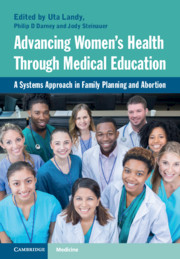 Advancing Women's Health Through Medical Education
Advancing Women's Health Through Medical Education from Section II - Integration of Abortion into Graduate Medical Education
Published online by Cambridge University Press: 30 July 2021
Abortion. The phrase “uterine evacuation” can create tension and line people up on opposite sides of the abortion issue, with no recognition of its safety, commonplace occurrence and health or life-saving capabilities. Due to the dichotomized and politicized nature of abortion, in some places it is difficult to teach health care providers how to empty a uterus, even in a life-threatening situation.Early pregnancy loss (EPL) management can provide an entry point for this education, as well as a way to destigmatize the uterine aspiration procedure and medical treatment because, although management is the same as for “elective abortion” the indication is different; with an abortion, a pregnancy is terminated that would otherwise likely continue, while with EPL, the pregnancy has ceased to be viable. This difference is subtle, yet concrete and profound for many.
To save this book to your Kindle, first ensure [email protected] is added to your Approved Personal Document E-mail List under your Personal Document Settings on the Manage Your Content and Devices page of your Amazon account. Then enter the ‘name’ part of your Kindle email address below. Find out more about saving to your Kindle.
Note you can select to save to either the @free.kindle.com or @kindle.com variations. ‘@free.kindle.com’ emails are free but can only be saved to your device when it is connected to wi-fi. ‘@kindle.com’ emails can be delivered even when you are not connected to wi-fi, but note that service fees apply.
Find out more about the Kindle Personal Document Service.
To save content items to your account, please confirm that you agree to abide by our usage policies. If this is the first time you use this feature, you will be asked to authorise Cambridge Core to connect with your account. Find out more about saving content to Dropbox.
To save content items to your account, please confirm that you agree to abide by our usage policies. If this is the first time you use this feature, you will be asked to authorise Cambridge Core to connect with your account. Find out more about saving content to Google Drive.